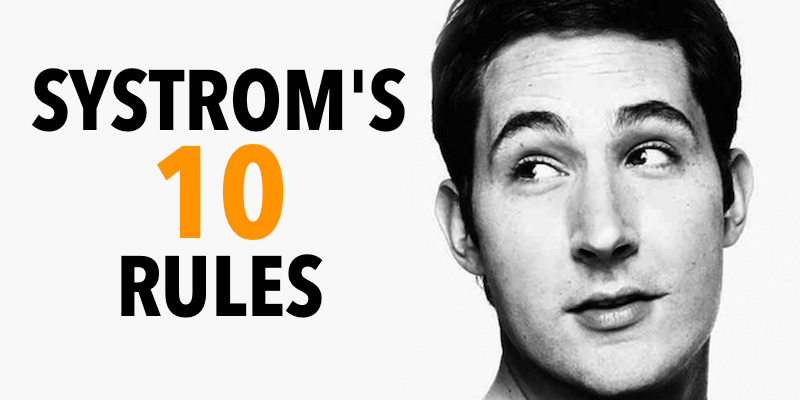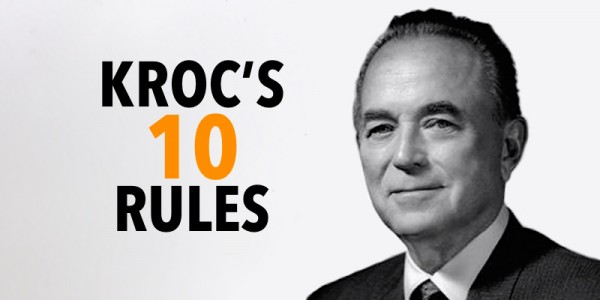Since launching in 2010 and being acquired two years later by Facebook for $1 billion with just 13 employees, Instagram has followed a meteoric path toward social media superstardom. Just 4 years after the sale, Instagram’s co-founder and CEO Kevin Systrom is now a billionaire.
Systrom has joined the three comma club in recent days thanks to the growth of Facebook’s stock. The original $1 billion deal was a mix of cash and stock — stock that rose from $18 a share shortly after the deal to over $120 a share today. Thanks to this stock growth, Systrom’s net worth has risen from $280 to an estimated $1.1 billion.

Here are 10 success lessons from Kevin Systrom – “Instagram Founder and Billionaire” for entrepreneurs,
1. Be passionate
Yes there are a whole raft of things you will need to get right in order to build a successful business. But no matter how complicated or chaotic things get, if you simply focus on these three fundamental factors you will greatly increase your chances of success.
Kevin Systrom looked for a way to share the things he loved about Polaroid pictures with millions of smart phone owners.
2. Have a deep focus
Instagram chose to focus on the iPhone initially and working on to make it better each day. It could have spread itself thin by creating apps for other mobile operating systems but seeing the rapid interest in the app by iPhone users, it chose to focus on its iPhone audience in its early years. In fact, it was because of this focus and dedication that Apple had picked it as the iPhone App of the Year in 2010.
3. Build up your skills
Though Kevin Systrom was formally hired as a product marketer at Google, he was a self taught programmer who had been tinkering with ideas and building out his ideas since he was a teenager.
While Systrom will likely win no awards in the programming hall of fame, it is still useful to note that he was not only interested in the marketing of products but in the thought process behind its design and code. Though he received no formal engineering training, he learned how to program at night and working on building his ideas.
4. Stay lean
Most people were astonished when they realized that Instagram only had 13 employees. The tendency among startup founders once they get a significant amount of funding is to hire fast so as to scale and capture marketshare.
However, sometimes the opposite might be the better strategy. By hiring great employees and staying laser focused on building a great product, a large staff base can often become a distraction or even a liability. Often, startups that stay lean, stay nimble. Only hire a crowd of engineers and business people if you have to.
5. Act small but think big
From the start, Instagram founder Kevin Systrom wasn’t shy about his large scale ambitions. In an interview with Time Magazine in 2011, he said he wanted to build a “social tool for social life on the go… we want to change the way people communicate and share in the real world.” There’s no doubting the fact that the Stanford graduate who had no experience running a company was determined and confident in his abilities.
What Systrom was shy about though, was scaling up his business operations. Unlike many other ambitious startups (who didn’t break it big), Systrom kept his organization lean and efficient. With only 13 employees, that’s a remarkable average of $76.9 million of value per employee.
6. Build users first, worry about revenue later
This is tough to swing if you don’t have the capital or funding, but the core value remains the same either way. I don’t care what kind of business you’re running: you absolutely need a critical mass of users and followers.
Whether you’re the new pizza shop in town or creating the world’s largest mobile sharing app, it doesn’t matter what kind of revenue you have today so much as what kind of loyal customer base you’re building. Without a loyal customer base, you’re dead in the water.
7. Success leaves tracks
“$0 To $1 billion In 18 months” might make for glamorous headlines but mainstream media does us no favours by glossing over the many years of learning, hard work and failure that go into these “overnight success” stories.
The reality is that Instagram founders Kevin Systrom spent years paying his dues and building his knowledge, skills, experience and contacts in the startup/tech space, working for a number of different internet giants including Google, Microsoft and Odeo (which later became Twitter). Not only that, but he had previous startups which failed along the way, enabling him to learn valuable lessons before he broke through with Instagram.
8. Grow your network
Hours after the launch of Instagram, the systems could not handle the thousands of downloads and kept crashing. Systrom was able to save the day by calling Adam D’ Angelo, someone he met at a Sigma Nu frat party back during his Stanford days. Not only did D’Angelo help with the back-ups, he also made investments into Instagram.
A few others funded Instagram too. Systrom used to work at Google, and over at the firm that eventually became Twitter. He was eventually introduced to businessman Marc Andreessen (of venture capital firm Andreessen Horowitz) by someone he knew from his Google days. Andreessen invested $250,000 into the app.
9. Know what works
Before Kevin Systrom came up with Instagram, he first thought of a service that was very much like Foursquare –location updates etc. – only that it came with a liquor-inspired moniker: Burbn.
But after Systrom and his partner started on their venture, they settled in on one of the most popular features of Burbn, which was photo-sharing. They did away with the Foursquarish appeal of Burbn, and ushered in something new and something simpler with Instagram.
10. Product name should reflect its purpose
As Burbn was streamlined down to Instagram, the purpose of the application changed from offering users several different capabilities to focusing on just one: images.
The name Burbn didn’t give any clues as to what the application actually did. Changing the name to Instagram more accurately reflected the capability of the new version of Burbn, which was to provide sharable cool images instantly.



